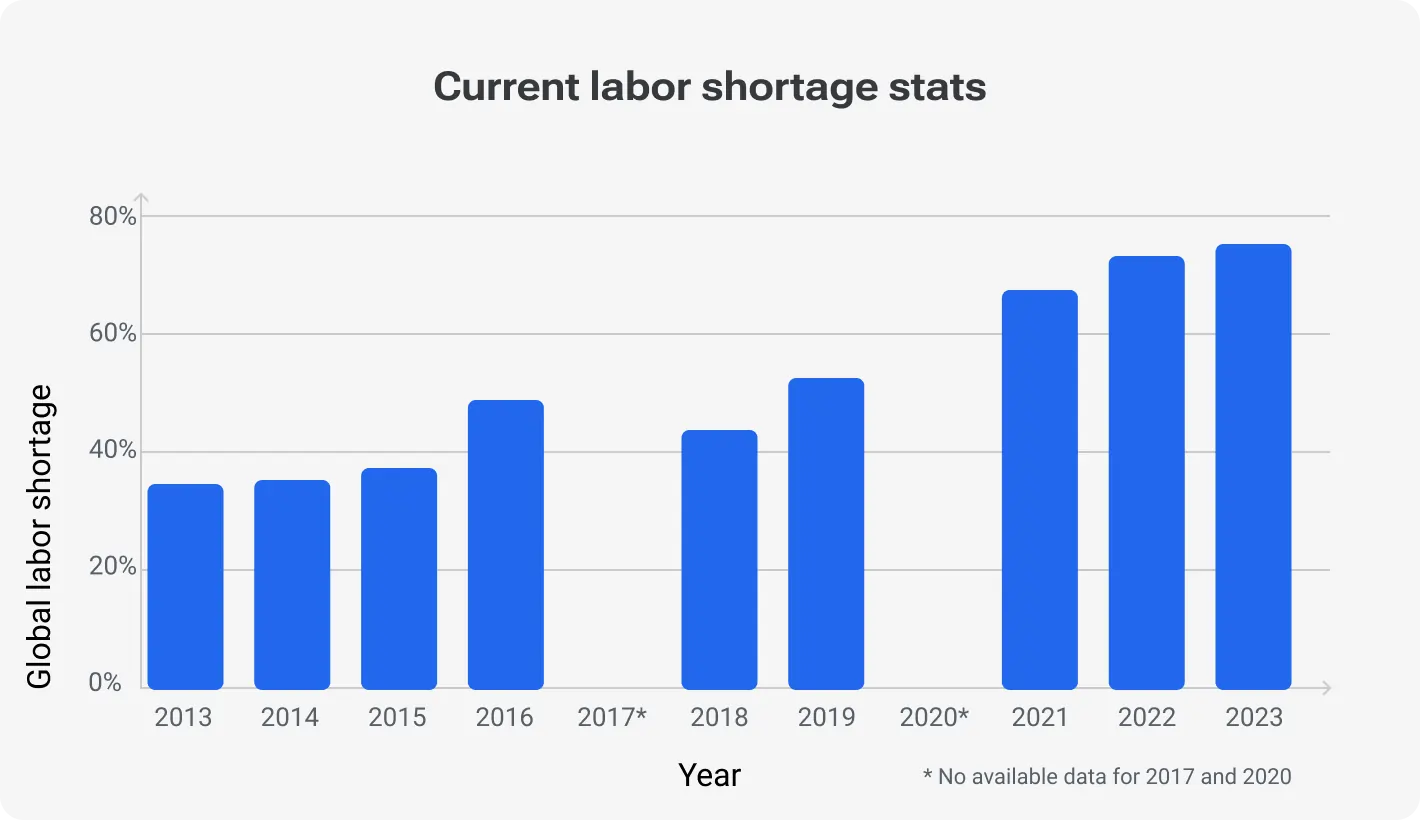Global crisis forces businesses to globalize. In this case, the demand for top talent has intensified, leading to significant talent shortages in major markets like the US and the UK. In the United States, 87% of retailers reported talent shortages as a primary challenge for 2023. Regarding the UK, approximately 1.25 million job vacancies reflect ongoing challenges in filling positions across various industries. Many agree that this was due to Brexit and demographic shifts.
This is where the EOR model comes into play. Employer of Record is a strategic solution for companies aiming to simplify the complexities of remote hiring. It’s when another company located in your target country/region legally employs staff on behalf of your company and handles all compliance, payroll, and HR responsibilities. This way, you quickly onboard talent from anywhere in the world without the logistical issues of navigating international labor laws yourself.
EOR services offer a valuable tool for companies looking to expand their talent pool beyond local borders, ensuring they remain competitive in a fast-paced global market.
5 key advantages of hiring through an EOR
We can name EOR hiring a tool, a secret weapon, or just a method for building a global dream team. Below are things and even conditions you can obtain with such an approach.
Free time: get rid of administrative tasks
One major advantage of an Employer of Record (EOR) is that they typically handle payroll, tax compliance, benefits administration, and other administrative tasks.
Take the load off yourself and your HR team and focus on strategic initiatives rather than day-to-day operational challenges. For example, Devico, as an EOR, can manage Ukrainian tax obligations under the constantly evolving tax regulations. We’re committed to ensuring compliance while mitigating the risks of penalties for non-compliance.
Enter rapidly: global expansion made easy
We’re not big fans of the lengthy process of setting up a legal entity in every market we want to hire from. Suppose you do too.
For this reason, EOR is your legal employer on paper which allows you to tap into new talent pools without the headache of establishing a local branch. We all know that speed sometimes makes a difference, especially when testing the waters in a new market.
Yet, local employment laws can be tricky. Here are just a few potential legal issues you might face:
Non-compliance fines: Hiring without proper legal registration can result in hefty fines from local authorities.
Employee misclassification: Misclassifying workers as independent contractors can lead to significant tax liabilities.
Employer branding damage: Negative experiences for international hires due to non-compliance can damage your company's reputation.
Save money and push them work
Saving: Hiring through EOR commonly leads to significant cost reductions since you don’t need local HR and legal infrastructures. Just list the top 10 your potential expenses when establishing a local branch:
Expansion experts for setup
Minimal capital requirements
Signature and notarization
Legal counsel hired for incorporation
Fees for setting up documentation
Legal representation to open the entity
And the list is incomplete! The overall entity cost can reach USD 120,000.
Take Deloitte’s work with the Canadian government as an example. Strategic outsourcing initiatives, including employment and payroll management through EORs, targeted a reduction in operational costs by billions, underscoring the cost-effectiveness of such strategies.
Pushing to work: Let's say a small marketing agency lands a new client in Spain. Hiring a full-time marketing coordinator in this country seems expensive (about USD 62,000, according to Deel). An EOR allows them to quickly bring on board a talented Spanish marketer without the burden of setting up a subsidiary or dealing with complex local employment laws.
Compliance and risk mitigation
EORs keep up-to-date with changing regulations, ensuring that your employment practices are compliant with local laws. This risk mitigation is critical, especially in regions with complex legal frameworks and frequent regulatory changes. It protects your business from potential fines and legal disputes that can arise from non-compliance.
We'll keep you compliant with local labor laws, so you can focus on building your global presence without legal headaches
Flexible workforce management
Using an EOR allows companies to manage workforce size flexibly. You can scale up or down without the complexities typically associated with changing a direct hire workforce, such as legal risks or extended HR procedures. This is particularly useful for project-based work or industries with fluctuating demand.
Addressing potential concerns
CEOs often have concerns when considering Employer of Record services. For your convenience, we have listed the top five common worries with practical solutions to each. As a bonus, we also listed tools that may help you during the EOR implementation.
Loss of control over staff
Problem: CEOs worry they will lose control over their employees when using an EOR.
Solution: Try to ensure your preferences. Choose a flexible employer of record that allows you to define roles and manage your team's daily activities while they handle compliance and payroll. You also can hold regular meetings to ensure alignment.
Tools for watching over politely:
Free: Use project management platforms like Trello or Asana. They are mostly paid, but almost all of them offer free plans with basic features like task assignment, communication tools, and progress tracking. If you are an SME owner, this is a perfect choice to hit the ground running.
Paid: If you have quite a serious attitude, consider an entire HRIS (Human Resource Information System) like BambooHR or Zoho People (both with free trials and paid plans). These integrate with payroll and other tools, providing a centralized platform for managing your entire workforce, including remote EOR-employed staff.
Hidden costs
Problem: The fear of unexpected fees with EOR services. Fear is not a problem itself. The problem is a potential budget gap.
Solution: Work with an EOR that guarantees transparency in their pricing structure. Request a detailed contract that outlines all potential costs and conditions to avoid surprises. This can help in planning and budgeting effectively.
Tools for transparency:
Free: Keep it simple — Google Sheets allows tracking and managing budgets, making it easier to see all associated costs.
Paid: QuickBooks offers comprehensive financial tracking and budget management that can help forecast and track EOR expenses clearly. We also suggest exploring cloud-based HR cost calculators (some EOR providers offer this tool).
Compliance risks
Problem: Common fear is that an EOR might not manage compliance effectively, leading to potential legal issues.
Solution: Double-check EOR by asking around his previous clients. Ensure they provide regular updates on compliance status and any legislative changes in the employee's location, which can help mitigate legal risks.
Compliance-related tools:
Free: The ILO's NATLEX database provides a wide range of international labor laws that can be accessed at no cost. It possibly can charge some money, yet generally provides free access to the information. However, as a goodwill sign, EORs must publish detailed security white papers on their websites. Check it on the off chance.
Paid: Thomson Reuters Compliance Learning offers tailored learning solutions for your team to stay ahead of regulatory challenges.
Quality of hires
Problem: Concerns about the quality of hires through an EOR can arise.
Solution: Clearly communicate your hiring standards and requirements to the EOR. Engage in the recruitment process by reviewing candidates they shortlist to ensure they meet your expectations. This involvement can help maintain the quality of your workforce.
Tools for quality assurance:
Basically, you can’t ensure quality beforehand. Yet, it makes sense to check testimonials and other related content about your potential employer of record.
Free: LinkedIn. This social media platform has a vast network of professionals allowing HR teams to vet potential candidates recommended by the EOR.
Paid: As an alternative you can use recruiting software. Such tools have screening features and applicant tracking. This is not a 100% guarantee for robust hires, yet, it enhances them.
Long-term commitment
Problem: Businesses often worry about being tied to long-term contracts with an EOR.
Solution: Look for EORs offering flexible service agreements that allow you to scale services as needed. Opt for trial periods to evaluate the EOR service before committing to a long-term contract.
Relevant tools:
Free: Docracy offers free contract templates that can be customized for flexible terms with your EOR provider.
Paid: DocuSign is another tool for securing and easy contract modification. With it, you can adapt terms as your business needs evolve.
To sum it up
We all depend on a robust team. And EOR services can be your magic wand for building one. They take the headache out of remote hiring, handling everything from payroll and taxes to compliance, so you can focus on building a strong employer brand and attracting the best people, regardless of location.
They also mitigate risks associated with international labor laws and can significantly reduce HR overhead. This way, your HR department can zero in on their real task — find and hunt genuine talent. Just picture how far you can go with reduced HR workload, faster time-to-hire, access to a global talent pool, and reduced costs and risks. Ready to unlock the potential of a global workforce? Devico also works with the EOR model tailored to meet your unique hiring needs. Book a free call and let us help you grow.
Want to know how your business may benefit from EOR?




